#and martin being lower to the ground means he can have a lower centre of gravity
Note
Yayy I just found your blog and I can add you to my list of shorter!martin artists. The number of people drawing Martin shorter than Jon is few and far between and it’s also the only height headcanon I’ve ever cared about. Also I can’t art so I have to get my tma art from outside sources
ANON IM A DUNCE I MEANT TO ANSWER THIS SOONER
anyway thank u sm ur so cute and my most recent post was specifically inspired by this ask ✨✨
#anon#asks#also i dont have anything against tall marts! i drew tall marts for a long time#but theres just something so special abt when they resemble those gay bitches from a bug’s life……#and martin being lower to the ground means he can have a lower centre of gravity#aint shit gonna knock him over#meanwhile tall jon? beautiful…… waifish……..#im spouting silly shit now but. this was very sweet thank you <333
8 notes
·
View notes
Text
29 November 2019
Manifesto destiny
What do this year's manifestos have to say about data, digital, open government and technology?
While we wouldn't expect them to get into the finer points of digital government and better uses of data in government - not in themselves the most doorstep-friendly of issues - there's a fair amount in there. Online harms, cybersecurity, citizens' digital rights, using data to better understand barriers to diversity (very Race Disparity Audit) and general references to technology across various sectors all make an appearance. There's not that much on open data or open government (beyond an eye-catching Lib Dem promise on a citizens' assembly on algorithms), or much detail on the Conservative promise to improve the use of data, data science and evidence in government (#classicdom). We've got a summary here, the Ada Lovelace Institute have one here, and Peter Wells has a thread on each here.
It's interesting to compare with the 2017 versions. The Conservatives apparently promised some new bodies on the use and ethics of data, and geospatial data - whatever happened to those? - while Labour promised to keep the Land Registry and all its data under public control (repeated this time around) and extend freedom of information to private providers of public services (ditto). No mention of Freedom of Information in the Lib Dem manifesto for the first time in a while.
There'll be some more on manifestos on this week's Inside Briefing podcast. We looked at, or rather listened to, prime ministerial tenure last week.
And in brief:
It was a real pleasure to chair Will from Full Fact, Liz from Digital Action, my old boss Martin from King's and the chair of the Electoral Commission, Sir John Holmes, on whether we can trust our electoral system in an age of rapidly evolving technology. All killer, no filler, as the kids say - well worth a watch or listen.
And if you liked that, you may like some of our other #IFGElection2019 events, including one next week on other aspects of our electoral system.
Another important event: on starting a career in public policy. Thinking about a career in public policy? Never thought about a career in public policy? Want to get started in thinktanks, or still wondering what a thinktank is? Come and have your questions answered on Monday 9 December.
To the Argentine Embassy for the launch of the Bennett Institute's new report on digital government in Argentina since 2015. Excellent discussion, excellent report, excellent empanadas.
No Data Bites next week - we're hoping to get started again in February. But as well as watching all the previous ones
back, you can join us for some drinks on Wednesday - get in touch via Twitter if you'd like to join.
RIP Clive James.
It's easy to forget in the midst of the election campaign but it is nearly Christmas. Come and celebrate with my choir, the New Tottenham Singers, on Saturday 14 December.
Have a great weekend
Gavin
Today's links:
Graphic content
Let's talk about MRP
The key findings from our MRP (YouGov)
Election Centre (YouGov)
MRP election poll: Boris Johnson heads for big majority* (The Times)
Poll forecasts Commons majority for Boris Johnson* (FT)
How do pollsters predict UK general election results? (FT)
Manifestos
Where does the climate emergency first get mention in the party manifestos? (Tortoise)
A chart based analysis of the text in the Conservative and Labour manifestos (Daniel Tomlinson)
Manifesto word count (me for IfG)
#GE2019, etc
Top target seats in the 2019 general election – interactive (The Guardian)
Meet Parliament’s class of 2019* (The Economist, via Tom)
What happens if a prime minister loses their seat in a general election? (IfG)
A New Class Of Angry Partisan Facebook Pages Are Dominating The Online War In The British General Election (BuzzFeed)
Trust in civil servants/politicians (me for IfG)
Veracity Index (Ipsos MORI)
We're now three weeks without a Secretary of State for Wales (me for IfG)
Long term trend shows decreasing concern over economy, unemployment, rise of Brexit (Ipsos MORI)
Women in parliament (Alice for IfG)
Tax and spend
This is how marginal taxes work (Mona Chalabi)
Explaining progressive income tax (Matthew Armstrong)
Divided and connected: Regional inequalities in the North, the UK and the developed world – State of the North 2019 (IPPR)
Elections elsewhere
Hong Kong election results mapped* (New York Times)
A Staggering Number of Candidates Are Running for U.S. President* (Bloomberg)
Who is ahead in the Democratic primary race?* (The Economist)
Everything else
How Do You Find Good NFL Defenders? By Measuring What’s Not There. (FiveThirtyEight)
A kaleidoscope of river pollution (The ENDS Report)
Die letzten Mieter (Zeit Online)
Pope Francis, globe-trotting at an age when other popes have eased up, is trying to transform the church through his travels* (Washington Post)
Data and #dataviz
Survey of public sector information management 2018/19 (data.gov.nz)
Make your own UK General Election maps (Flourish)
Lowering the bar (Full Fact)
Reddit's Bar Chart Race moratorium is a good thing for #dataviz. Here's why. (Andy Cotgreave)
Meta data
Poll position
How YouGov's 2019 General Election model works (YouGov)
FAQs about YouGov's 2019 general election MRP model (YouGov)
MRP Estimates and the 2019 General Election (Anthony B. Masters)
Why you should take YouGov's MRP with a pinch of salt; Six thoughts on YouGov's MRP model of the 2019 election* (New Statesman)
Brexit didn’t cause all our divisions (UnHerd - although...)
Forensic polling analysis shows how Boris Johnson is on course to win—and how he can be stopped* (Prospect)
What to make of the polls? (Will Jennings)
The hidden predictor? Council control (Ian Warren)
Four Problems With 2016 Trump Polling That Could Play Out Again in 2020* (New York Times)
Election 2019: Can we trust our electoral system? (Institute for Government)
Manifestos
General Election 2019: manifesto tracker (Institute for Government)
Manifestos still matter even though their promises aren't being delivered (Institute for Government)
Tech/data in the 2019 manifestos (Peter Wells)
How will data and AI work for people and society after the UK General Election 2019? (Ada Lovelace Institute)
2019 Manifesto - 'Towards a Better Future' (techUK)
The Startup Manifesto (The Entrepreneurs Network/Coadec)
Future of the web
Contract for the Web (World Wide Web Foundation)
Tim Berners-Lee unveils global plan to save the web (The Guardian)
Read Sacha Baron Cohen's scathing attack on Facebook in full: 'greatest propaganda machine in history' (The Guardian)
Platforms don't exist (Ben Tarnoff)
Internet Harms: We need a Regulator, not a Censor (Martin Stanley for the Bennett Institute)
Internet world despairs as non-profit .org sold for $$$$ to private equity firm, price caps axed (The Register)
Oil, data, data, oil
Oil is the New Data (Logic)
The Next Big Cheap: Calling data “the new oil” takes its exploitation for granted (Real Life)
Data, transparency, openness
Unlocking the value of London’s public sector data (Eddie Copeland)
What does transparency mean? (Understanding Patient Data)
Open government must be more than a commitment on paper* (Apolitical)
11 thoughts on Donald Trump, Transparency and Records (Ben Worthy)
Cabinet Office ignores court order to release secret fracking report (The Guardian)
Open Banking: Consumer consent frameworks around the globe (ODI/Equifax)
Thierry Breton to be in charge of leading new ‘EU data strategy’* (Politico)
Everything else
Better than ethics (Rachel Coldicutt, Doteveryone)
Help TheyWorkForYou make sense of Parliament (Crowdfunder)
Taiwan is making democracy work again. It's time we paid attention* (Wired)
Facebook’s only fact-checking service in the Netherlands just quit (The Verge)
OPSI Primer on AI for the Public Sector (OECD, via Marcus)
Opportunities
AWARD: 2020 Statistical Excellence in Journalism awards launched (Royal Statistical Society)
JOB: RESEARCHER/POSTDOCTORAL SCHOLAR, AI ON THE GROUND INITIATIVE (Data & Society)
JOB: Director of Standards & Interoperability (NHS England)
JOB: Senior Researcher: Court Monitoring and Open Justice (Spotlight on Corruption)
JOBS: 2020 US Election (FT)
JOBS (Luminate)
And finally...
Thanksgiving
The Ultimate Thanksgiving Dinner Menu (FiveThirtyEight)
9 charts to be thankful for this Thanksgiving (Vox)
Practice makes perfect: Carve this virtual turkey* (Washington Post)
Politics
How the UK are predicted to vote is... (@notstelfc, via Haydon)
Winning here. Hang on... (via Alasdair)
Medieval Catholicism nudged Europe towards democracy and development* (The Economist)
Irish parliament red-faced over printer too big to fit through doors (The Guardian, via Alice)
Fibonacci Day
Fibonacci Anonymous meetings this afternoon... (Moose Allain)
A poem (Brian Bilston)
Everything else
How Emojis Have Invaded the Courtroom (Slate)
The Big Data of Big Hair (The Pudding)
Same. (@kamal_hothi)
Day in the life of a data journalist. (David Ottewell, via Graham)
Warning: Reading the Wikipedia entry for the guy who invented the bar chart will give you multiple cases of serious whiplash (Tom Wilson, via Tim)
Hi, I'm Bill gates and today I will teach you how to count to ten (@OneDevloperArmy)
2 notes
·
View notes
Text
Week 4

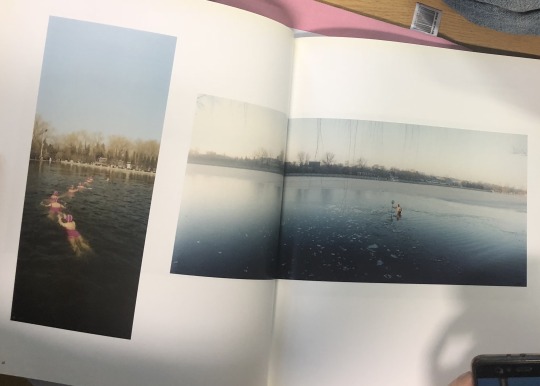
Noguchi Rika
About The World Below Zero
First Impression
Cold. Silent. Drumming in the ears.
Themes
These photographs can tell a story when viewed as a whole, which makes them a series rather than just a collection of pictures.
The photographs were all shot by wide-angle lens, cropped into narrow rectangles. Two horizontal photographs of the series have similar angles: the horizon is at the third of the photo. The vertical photograph of the series also has same horizon line as the horizontal ones which is formed by a withered and melancholy forest. The photographs are of a team of men and women swimming together in freezing conditions in a half frozen lake. The photographs are about the nobleness of persistence. With cold hue and large area of leaving blank, the series has a strong ceremonial sense for saluting the people’s action.
Title
The title About the World Below Zero frames the series with a freezing atmosphere. It emphasises the chill mood of my reading of the images.
Sequencing
The author chose a spatial and thematic arrangement for the photographic series. The spatial arrangement is from Medium Long Shot, Long Shot, to Extra Long Shot. The thematic arrangement is from getting ready, swimming, to taking a break. For the first photograph, a man stands at the centre of the frame, posing in a diving position, conveying to viewers a strong ceremonial sense. For the second photograph, a team of women, lining up in piercingly cold water, swam to the distance. For the third photograph, a man stood alone in the vast lake. This arrangement adds a rhythm to the reading of the photographs.
Last Impressions and Self-Assessment
My first impressions of the series are cold, silent and drumming in the ears. Now it changes to cold, but whistling.
British Food
Martin Parr
1995
The artist is trying to show British culture with this work of British grub. He is trying to say ‘we are what we eat’.
The food is not tempting, but grim. Instead of making me hungry, Parr’s series of British Food seems to make me lose appetite.
They have either food or close-up human figures.
They were shot with macro lens and ring flash, edited into saturated tones, like medical images.
- Why did you shift from black and white to colour in 1983, choosing such saturated tones?
- Because that’s the language of commercial advertising.
The sequencing of the images is relevant, but not fixed. The series follows a thematic sequence. Two to three food photographs will be followed by one to two human figure photographs. This sequence will never make the stories or the scenes devoid of people. In filming language, it is also a montage sequence. Wake up, have breakfast, then take a look at the scenery, smoke, eat desserts, have lunch, bake a loaf of bread, drink a cup of tea. What distracts me is the photograph at the lower left corner, a hand with wrinkles and some seemingly valuable rings. I am still confused of its meaning. What is it about?
The title of the series is British Food. British, as a word of nationality, implies viewers that the photographs are about culture. Without the title, I might perceive the photographs as merely some close-up shots of grim and dreary food. The title suggests Parr's challenge to national pride. Thanks to the title, I can feel the photographers’ sharp self-mockery and self-introspection.
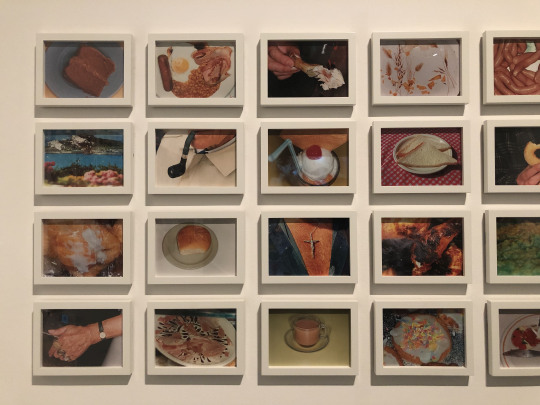

My Own Photographs:
Beautiful Pictures of Something Ugly
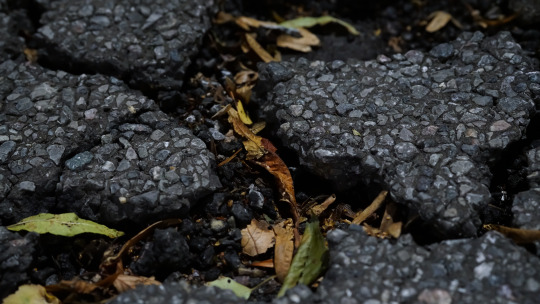
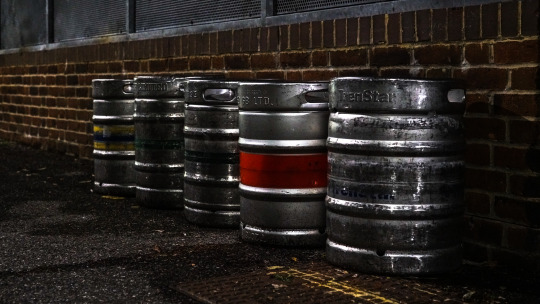
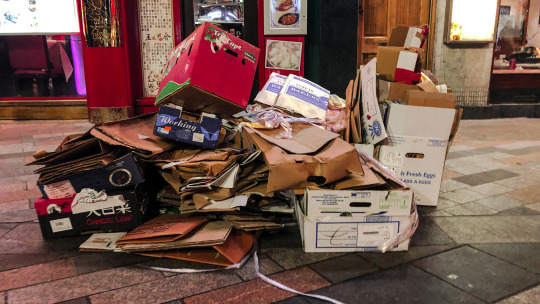
The topic I chose is “beautiful pictures of something ugly”. My subjects are those close to us, visible everywhere, but unlikable for people to get approach to. They are ugly to different extents for the appearances. As Robert Capa, one of the greatest photographers in the world, said that, “If your pictures aren't good enough, you aren't close enough.” I want to get closer and closer to those considered as “the ugly” in our common sense, stopping when I could observe their unknown sides, which are their beautiful sides as well. That’s the reason that why I chose cracked asphalt pavement, abandoned gas tanks, and waste cartons as my subjects. I would walk by these things every day, but I barely noticed that they could be seen as some beautiful objects.
For the first photograph, I bended down my knees and clicked the shutter. Before I cropped the photo, the subject cannot even be found in the picture — They were too negligible. After being cropped, the cracked textures of asphalt road and the defoliation reveal as a whole, presenting a sort of vulnerable aesthetic feeling.
For the second photograph, I stepped on the oily ground and clicked the shutter. After I increased the clarity of the picture by Adobe Lightroom, the abandoned gas tanks reflected a charming metallic lustre.
For the third photograph, I stood in the crowd and waited for a moment devoid of people. The colour of the waste cartons caught my eyes. The piles of cartons stood among the flushing crowd peculiarly, all alone.
0 notes